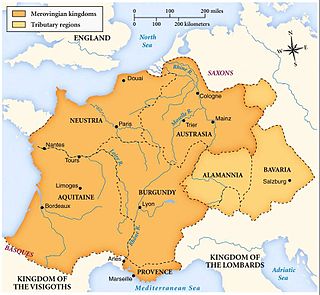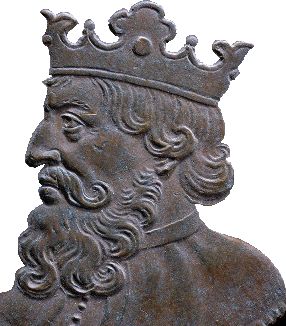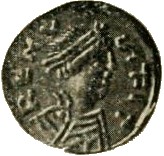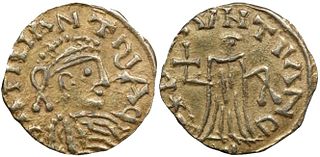
The Merovingian dynasty was the ruling family of the Franks from around the middle of the 5th century until 751. They first appear as "Kings of the Franks" in the Roman army of northern Gaul. By 509 they had united all the Franks and northern Gallo-Romans under their rule. They conquered most of Gaul, defeating the Visigoths (507) and the Burgundians (534), and also extended their rule into Raetia (537). In Germania, the Alemanni, Bavarii and Saxons accepted their lordship. The Merovingian realm was the largest and most powerful of the states of western Europe following the breaking up of the empire of Theodoric the Great.
The 580s decade ran from January 1, 580, to December 31, 589.

Gregory of Tours was a Gallo-Roman historian and Bishop of Tours during the Merovingian period and is known as the "father of French history." He was a prelate in the Merovingian kingdom, encompassing Gaul's historic region.

Clotilde, also known as Clothilde, Clotilda, Clotild, Rotilde etc., was a Queen of the Franks. She was supposedly descended from the Gothic king Athanaric and became the second wife of the Frankish king Clovis I in 493. The Merovingian dynasty to which her husband belonged ruled Frankish kingdoms for over 200 years (450–758).

Chlothar II, sometime called "the Young", was king of the Franks, ruling Neustria (584–629), Burgundy (613–629) and Austrasia (613–623).

Chilperic I was the king of Neustria from 561 to his death. He was one of the sons of the Frankish king Clotaire I and Queen Aregund.

Chlothar I, sometime called "the Old", also anglicised as Clotaire, was a king of the Franks of the Merovingian dynasty and one of the four sons of Clovis I.

Childebert II (c.570–596) was the Merovingian king of Austrasia from 575 until his death in March 596, as the only son of Sigebert I and Brunhilda of Austrasia; and the king of Burgundy from 592 to his death, as the adopted son of his uncle Guntram.

Sigebert I was a Frankish king of Austrasia from the death of his father in 561 to his own death. He was the third surviving son out of four of Clotaire I and Ingund. His reign found him mostly occupied with a successful civil war against his half-brother, Chilperic.
Fredegund or Fredegunda was the queen consort of Chilperic I, the Merovingian Frankish king of Soissons. Fredegund served as regent during the minority of her son Chlothar II from 584 until 597.

Saint Gontrand, also called Gontran, Gontram, Guntram, Gunthram, Gunthchramn, and Guntramnus, was the king of the Kingdom of Orléans from AD 561 to AD 592. He was the third-eldest and second-eldest-surviving son of Chlothar I and Ingunda. On his father's death in 561, he became king of a fourth of the Kingdom of the Franks, and made his capital at Orléans. The name "Gontrand" denotes "War Raven".

Venantius Honorius Clementianus Fortunatus, known as Saint Venantius Fortunatus, was a Latin poet and hymnographer in the Merovingian Court, and a bishop of the Early Church who has been venerated since the Middle Ages.
Brunhilda was queen consort of Austrasia, part of Francia, by marriage to the Merovingian king Sigebert I of Austrasia, and regent for her son, grandson and great-grandson.

Radegund was a Thuringian princess and Frankish queen, who founded the Abbey of the Holy Cross at Poitiers. She is the patron saint of several churches in France and England and of Jesus College, Cambridge.

Audovera was the first wife or mistress of Chilperic I, king of Neustria.

The Church of Sainte-Radegonde is a medieval Roman Catholic church in Poitiers, France, dating from the 6th century. It takes its name from the Frankish queen and nun, Radegund, who was buried in the church. Considered a saint, the church became a place of pilgrimage by those devoted to her heavenly intercession. The current church, constructed from the 11th to 12th centuries, was built in a combination of Romanesque and Angevin Gothic architectural styles.
Ingunde, Ingund, Ingundis or Ingunda, was the eldest child of Sigebert I, king of Austrasia, and his wife Brunhilda, daughter of King Athanagild of the Visigoths. She married Hermenegild and became the first Catholic queen of the Visigoths.

The Abbey of the Holy Cross was a French Benedictine monastery of nuns founded in the 6th century. Destroyed during the French Revolution, a new monastery with the same name was built in a nearby location during the 19th century for a community of Canonesses of St. Augustine of the Mercy of Jesus.
Egidius was a nobleman from Austrasia was a bishop of Reims (573-590). An influential person during the minority of King Childebert II, he favored an alliance with Chilperic I. In 575, along with Rauching, Bertefred and others, he was one of the regents.
Maroveus was the bishop of Poitiers in the late sixth century. He became bishop between 565 and 573, serving until sometime between 590 and 594.













